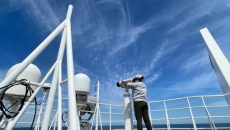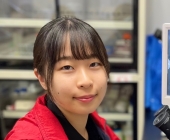Participating in an Antarctic Ocean research voyage as a student researcher: what did you learn and what impressed you?

Miku Narusawa(2nd year Environmental Engineering for Symbiosis Major Graduate School Graduate School of Science and Engineering)
Miku Narusawa, who studies zooplankton that live in the Southern Ocean (the waters around Antarctica), participated in a Southern Ocean observation cruise as a joint researcher at the National Institute of Polar Research from January 11 to February 9, 2024. As one of the few student researchers, Narusawa spent about a month living on board the ship while working on her research. We spoke to her about the observations and experiments she undertook in the extremely cold Southern Ocean, where sea ice floats, and what she learned there.
Could you tell us how you ended up participating in the Southern Ocean observation voyage?
It all started when my supervisor, Professor Norio Kurosawa, approached me about it. Since I was a fourth-year undergraduate, I have been researching copepods, a type of zooplankton found in the seawater and drift ice of the Southern Ocean, in Professor Kurosawa's laboratory. Because the National Institute of Polar Research cooperates with me in obtaining samples necessary for research, and because senior members of my laboratory had also participated in this voyage in the past, I was recommended as a student researcher and given the valuable opportunity to participate in the observation voyage.

What kind of research is being conducted on copepods at universities?

Copepods are a type of crustacean, like shrimp and crabs. Although they are small, measuring 1mm to 1cm in size, they live throughout the ocean and are said to be the animals with the largest biomass in the ocean. They feed on phytoplankton and other organisms, and serve as food for fish larvae and young fish, so they play a very important role in the marine ecosystem.
I am researching three species of copepods, all of which are known to live not only in seawater but also on drift ice. However, there is still much we do not know about their ecology, such as why they choose to live in cold waters or how they get onto drift ice, and there has not been much previous research on them.
So in my research, I use melting ice collected in the Southern Ocean to calculate the population density of each species (the number of individuals per volume of ice) and conduct genetic analysis. Observing melting ice under a microscope and conducting experiments to extract DNA from each individual is very painstaking work, but I am proud to be able to use samples delivered all the way from the Antarctic Ocean to reveal with my own hands the ecology of organisms that are still unknown to the world.
What kind of research did you conduct on this Southern Ocean observation voyage?
The observation team, including myself, boarded the Tokyo University of Marine Science and Technology's training ship "Umitaka Maru" from Fremantle Port in southwestern Australia, and conducted various observations while crossing the Antarctic Ocean's ice margin (the area near the edge of the sea ice that covers the ocean) toward Hobart on the island of Tasmania, Australia. Specifically, in cooperation with the researchers and crew members on board, we collected vertical data using observation equipment and water samplers equipped with many sensors, and collected fish and plankton, and were able to obtain important data for understanding the ecosystem and its changes over time.
In addition, we collected copepods and other creatures from the seawater at the ice margin and conducted an experiment to clarify their salinity tolerance. The results of the experiment are still being analyzed, but we hope that the results will deepen our understanding of the ecology of organisms in the Southern Ocean. Initially, we had hoped to bring back live copepods from the site, but the conditions were not right and we were not able to make this happen, which is a bit disappointing.

What did you learn and what difficulties did you face during your voyage in the Southern Ocean?

It was my first time to go on a long-term voyage and to the Southern Ocean, so I really learned a lot. In particular, while on board, I participated in many observations that were not related to my research topic, and was able to thoroughly learn about the methods and analysis of marine observations, which was a great benefit. During my undergraduate years, I learned basic methods and techniques for marine observations in oceanography practical classes, but observation work on a large ship and observations using the latest sensors are experiences that can only be experienced in the field, so I was able to gain new knowledge every day. I was the only one from Soka University who joined the observation team, but the observations were carried out with the cooperation of researchers, student researchers from other universities, crew members, and students from Tokyo University of Marine Science and Technology who were undergoing practical training in operating a ship, and I was reminded once again that "research cannot be done alone."
I learned a lot, but I also had a lot of hardships. Seasickness is particularly memorable. It's an inevitable part of any sea voyage, and Professor Kurosawa and my seniors had warned me to "always take medicine to prevent seasickness," but the weather was fine and the sea was calm before we set sail, so I let my guard down and got on board without taking any medicine. However, once the ship left port, the storm turned violent, and I ended up suffering from severe seasickness... On January 11, the day we set sail, rice cakes were served on board for the sake barrel opening ceremony, but I was unable to get out of bed, let alone eat, so I missed out on eating them. Even now, I regret not taking medicine (laughs).
Was there anything that impressed you on the ship?
I was deeply moved when I was able to see with my own eyes the homeland of the copepods, which I had only seen in photographs until then. The ice edge is rich in nutrients, and phytoplankton flourishes, making the sea appear green on some days. Seeing this natural scenery for myself has also increased my motivation for research.
In addition, since I had wanted to study marine environments and organisms since high school, my first choice for university entrance exams was Tokyo University of Marine Science and Technology, which has the Umitaka Maru, the ship I boarded this time. Unfortunately, I was not accepted and instead went on to Faculty of Science and Engineering at Soka University, but my renewed determination and hard work at Soka University bore fruit, and I was really happy to be able to board the Umitaka Maru, a ship I had hoped to board in high school, in an unexpected way.


What was your biggest impression from your studies and activities at Soka University?

Department of Science and Engineering for Sustainable Innovation where I studied offers classes in a wide range of fields, including biology, environment, chemistry, and physics, and I think it was an environment where it was easy to challenge yourself to study a field that you were even slightly interested in. I was able to take a variety of classes, including soil, plants, genes, life science, and the environment, in addition to the marine-related classes I originally wanted to study. I believe that it was only by studying at Soka University's Faculty of Science and Faculty of Science and Engineering that I was able to acquire not only knowledge in my field of expertise, but also a broad perspective that allows me to consider various approaches to research, and a wide range of knowledge that is useful when talking with researchers in other fields.
I also belonged to an organization in Faculty of Science and Engineering that planned and managed events, and I have fond memories of demonstrating a "mini dust explosion" experiment using flour and a candle at the Soka University Festival.
As an extracurricular activity, I belonged to the women's soccer club, and although there were times when it was difficult to do activities due to the COVID-19 pandemic, we were able to practice with a small number of people in an ingenious way, practice with students from other universities, and spend a fulfilling time. What I will never forget is scoring my first goal in an official match. It wasn't a very cool goal, but I felt like all the days of practice had paid off.
What are the career paths available after graduating from graduate school?
I plan to work in software and systems research and development at an IT company that also handles software related to space development and the global environment. I want to bring products that utilize my ideas to the world, solve social issues, and do work that is useful to people.

Please give a message to your juniors who are aiming to enter Soka University.

As I mentioned earlier, I had a failure in my university entrance exams, so I enrolled in Soka University with the mindset of "I'll just find out what I want to do after I get in." However, seeing my friends tackling academics with great ambition and facing difficulties made me seriously think about what I like and what I want to do. As a result, I became motivated to continue taking the teaching classes I had been unsure about, and to study the ocean, and I came to believe that nothing is a waste, and that I should do my best in everything I can do now. My enthusiasm in research led me to participate in this research cruise, and now I believe that everything, including the failure I experienced before enrolling, was an important experience.
At Soka University, you will find fellow students who will support you in your goals, as well as caring teachers and staff members. Whether you know what you want to do or haven't yet found it, we hope you will take on new challenges, discover your dreams, and make them come true, all while being supported by many people at Soka University.

[Favorite saying] Optimistic people are strong
[Personality]
I'm fine, I don't care about the details
[hobby]
Traveling, watching sports, eating
[Books I've read recently]
Let's defeat the locusts in Africa / Maeno Urudo Kotaro





